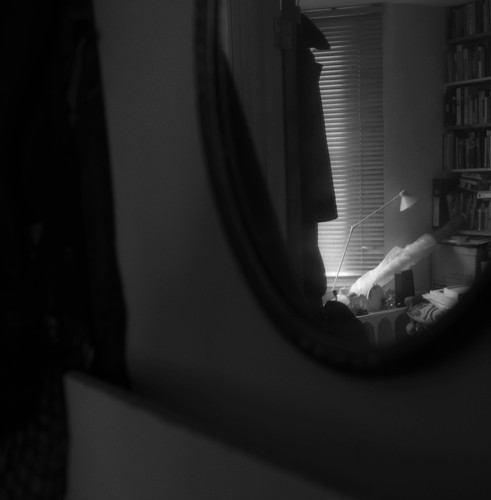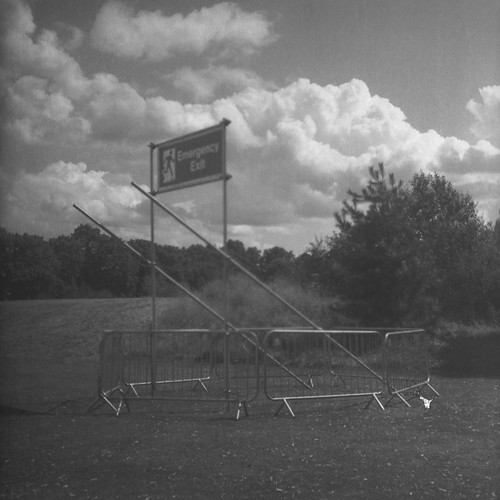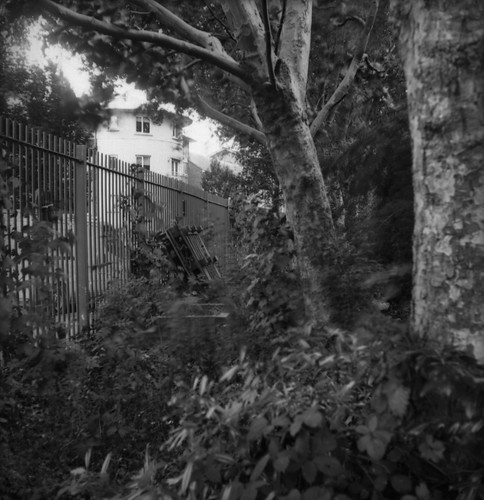 |
| Rolleiflex 4x4 with Kodak High Resolution Aerial Duplicating Film |
After my recent testing of the
Rolleiflex 4x4, I naturally wanted to use it on last week's
127 Day; I didn't have any film in medium format to
cut down to 127 to use on the day itself, as I might normally do. However, in cutting down 120 film to the width of 127, as the film is also longer, there's always an offcut of three or four frames, depending on the frame size of course; I did have one such short roll of
Ilford FP4 Plus, which I simply shot the same scene over three frames with bracketing.
 |
| Rolleiflex 4x4 with Ilford FP4 Plus |
I also shot the roll of Kodacolor II which had originally come with a
Kodak Brownie 127 and which I hadn't previously used: I had low expectations for this film considering its age and that the roll of Agfacolor Special which also came with the camera and that I had short for last year's
Summer 127 Day had only yielded one poorly defined image (I might have used the Kodacolor II film then had I not broken the camera). Using the Rolleiflex 4x4 did mean that I could give the film much more exposure than that of the Kodak Brownie 127 which has a single shutter speed and aperture, and so I used a tripod and bracketed exposures, erring on the side of considerable overexposure - which did provide better results than I had achieved with the Agfacolor film twelve months ago.
 |
| Rolleiflex 4x4 with Kodacolor II |
The metal spool that the film was on was rusty, and the backing paper was partially stuck to the film, although this seemed to be mostly on the reverse of the film, not the emulsion side, and could be gently rubbed off in the wash. I used stand development with the film to get a black and white negative image, successfully for a few frames, although in comparison with the image above, the one below is out focus in the central area, suggesting that film flatness was a problem, perhaps unsurprising given that the film itself had been tightly coiled around the 127 spool for forty years.
 |
| Rolleiflex 4x4 with Kodacolor II |
Most of the photographs that I took on the day were with
Kodak High Resolution Aerial Duplicating film cut down by hand to 127 size. This was rated at an exposure index of 2, and, having a lot of the film to play with, I also bracketed most of the shots, partially for exposure, but also, shooting long exposures on the shutter's B setting (again with a tripod), I was aware of either the possibility of inadvertent shake from holding the shutter release down (which is one reason for liking older shutters with a T setting), or from the breeze causing elements of the subject to move. As well as being very slow in terms of exposure, the Kodak High Resolution Aerial Duplicating film is also high contrast and blue sensitive, making for an interesting comparison with the black and white version of the Kodacolor II film; the shot below
just holds some information in the sky, but essentially bleaches it. Other colours render in very different ways on the film: in the image at the top of the blog, the apples, although far from ripe, are a russet colour, which appears notably dark in the photographs. The look is quite different from the usual panchromatic rendering of most black and white film, and has a distinct feel, even when used for subjects where this effect isn't quite so clear. One of the problems I had when using the Kodak High Resolution Aerial Duplicating film straight after the Kodacolor II film is that there was a fair amount of dust in the camera caused by the rust from the metal spool, which caused a fair bit of spotting on subsequent frames, particularly at the edges from the spool flanges. The grain of the Kodak High Resolution Aerial Duplicating film is so fine as to be virtually invisible, at least within the scope of using a flat bed scanner with the film and this shows how well the Xenar lens on the Rolleiflex 4x4 performs: apart from the spotting - some of which may be due to development - the film's grain is so fine that there is a danger of banding in areas of smooth tonal transition, a problem I've only really experienced before with
Kodak Technical Pan.
 |
| Rolleiflex 4x4 with Kodak High Resolution Aerial Duplicating Film |
 |
| Rolleiflex 4x4 with Kodak High Resolution Aerial Duplicating Film |
 |
| Rolleiflex 4x4 with Kodak High Resolution Aerial Duplicating Film |
 |
| Rolleiflex 4x4 with Kodak High Resolution Aerial Duplicating Film |
 |
| Rolleiflex 4x4 with Kodak High Resolution Aerial Duplicating Film |
 |
| Rolleiflex 4x4 with Kodak High Resolution Aerial Duplicating Film |
 |
| Rolleiflex 4x4 with Kodak High Resolution Aerial Duplicating Film |
 |
| Rolleiflex 4x4 with Kodak High Resolution Aerial Duplicating Film |












No comments:
Post a Comment